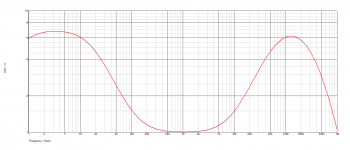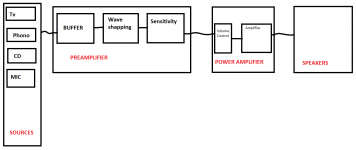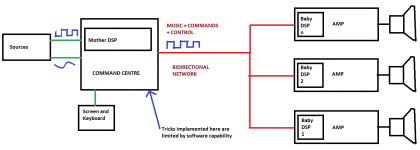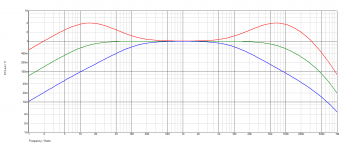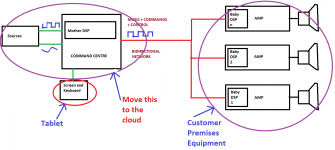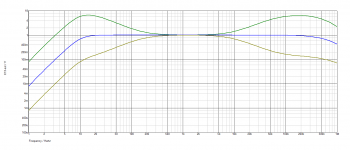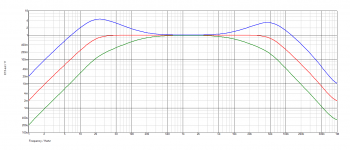Assuming your graph represents full boost action only of the bass and treble controls, there seems to be only minimal boost available in the audible region and a waste or even troublesome amounts of it in the sub and supersonic regions.
It's now usual to shelve the tone control responses to provide more useful boost/cut in the audible region and prevent speaker or even amplifier damage.
It's now usual to shelve the tone control responses to provide more useful boost/cut in the audible region and prevent speaker or even amplifier damage.
Since you have a tone control, why not expand it to bass/mid/treble and for good measure throw in a loudness control and balance control. Some may also like a stereo width control. Lets go back to the era of the fanatic knob twiddler.
And what about classifying tubes as ASPs from now on.. Analogous Sound Processors.
Thank you all
Balance control is in order
Loudness...not critical the tones will do
Stereo width ....well...
The shape of the curves is an attempt to minimize mid band interaction. Also here we are trying to adjust the fringes of the bass and high frequency drivers, the tone has sub woofer capability . Shelving filters would be away to go to handle this. Found an interesting article here http://www.rane.com/pdf/acceler.pdf
. Shelving filters would be away to go to handle this. Found an interesting article here http://www.rane.com/pdf/acceler.pdf
With the shape of the tone controls bass boost, it maybe advisable for your phono preamp to feature a steep rumble filter. The high frequency response could also be shaped with a low pass filter.
In order to avoid fanatic knob twiddling we could go the way of a DSP based preamp with on board computer featuring a mic, auto detect for (sealed box, open baffle, hybrid, ported etc) and auto calibration. On adjusting the volume it automatically compensates the frequency curves and factors in the time of day, ambient noise, mood and music type etc.
we could go the way of a DSP based preamp with on board computer featuring a mic, auto detect for (sealed box, open baffle, hybrid, ported etc) and auto calibration. On adjusting the volume it automatically compensates the frequency curves and factors in the time of day, ambient noise, mood and music type etc.
The purist will shun op-amp based preamp solutions. Discrete circuitry is the in thing.
If we initially wanted to keep it simple and functional wouldn't this do ? Or what must go or what must be added ?
Balance control is in order
Loudness...not critical the tones will do
Stereo width ....well...
The shape of the curves is an attempt to minimize mid band interaction. Also here we are trying to adjust the fringes of the bass and high frequency drivers, the tone has sub woofer capability
With the shape of the tone controls bass boost, it maybe advisable for your phono preamp to feature a steep rumble filter. The high frequency response could also be shaped with a low pass filter.
In order to avoid fanatic knob twiddling
The purist will shun op-amp based preamp solutions. Discrete circuitry is the in thing.
If we initially wanted to keep it simple and functional wouldn't this do ? Or what must go or what must be added ?
Hi all,Here are the curves from the latest mod.
These curves are not bad , can be compared to Self's, small signal fig 11.8, 11.7 and 11.9, it falls in some where there. Also the B5 bass curve can serve as a reference http://www.firstwatt.com/pdf/prod_b5_man.pdf, although the B5 does more than that. Also Linkwitz has some interesting curves here Linkwitz Lab - Loudspeaker Design.
But please this is still open to discussion.
kind regards,
Harrison.
Here are the curves from the latest mod.
The Bass is marginal while the treble borders on useless. You will not like how it works.
G²
Here are the curves from the latest mod.
The Bass is marginal while the treble borders on useless. You will not like how it works.
G²
Comments welcome, also there is an interesting article in the MIX magazine Dec 2011 page 60. Seems this kinda pre amp is hot at the moment.
It was hot 35 years ago too - I remember building something similar . . . with LF356 op-amps (very late 70's in my youth) . . .
Your tone control curves are looking quite good, and the return to zero is very important if you want to avoid amplifying supersonic noise etc.
Here are the curves from the latest mod.
Look at Hi-Fi Preamplifier by ESP. This design gives a more sensible and subtle tone adjustment range of +/-10dB whereas the more "traditional" designs use +/-20dB.
I built this circuit using LM4562 op amps, have used it for around 18 months and find the quality and adjustment range excellent. The gentle tonal corrections it offers seem perfect when compensating for the room acoustics.
Regards,
currentflow
- Status
- This old topic is closed. If you want to reopen this topic, contact a moderator using the "Report Post" button.
- Home
- Amplifiers
- Solid State
- HAL PREAMPLIFIERS

